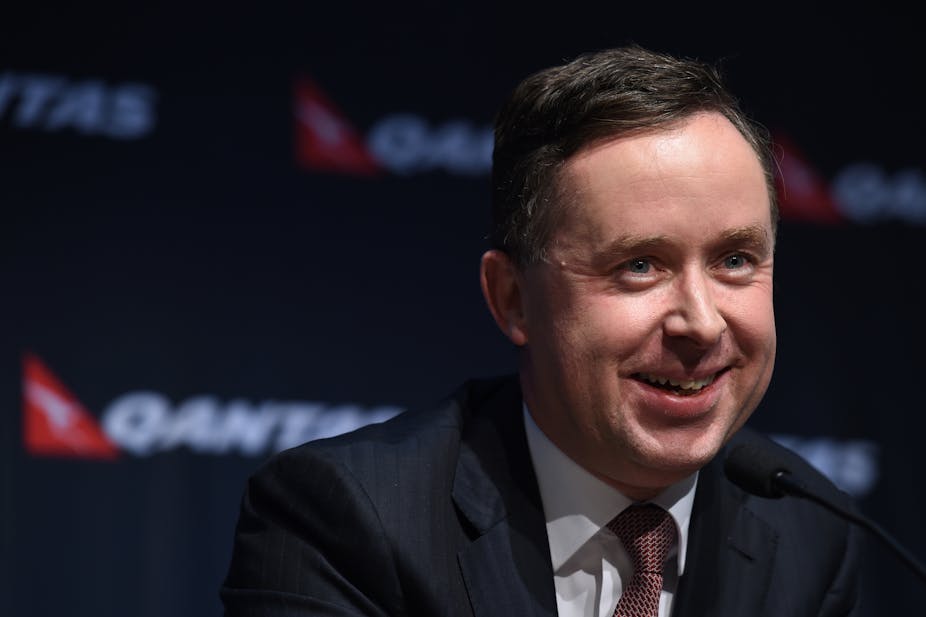Qantas has come a long, long way since the federal government rebuffed its request for corporate welfare last year, and it moved to cut 5000 jobs. At the time many observers, myself included, were calling for Joyce’s resignation – if not sacking. Based on last week’s results, a A$1.6 billion turnaround, it looks like Joyce’s critics were completely wrong.
Last year I set out a three point test for corporate turnarounds:
- Re-establishing product market presence
- Gaining control over the financial statements (income statement and balance sheet)
- Ridding itself of senior management.
It looks like Qantas has turned itself around on the first two points. Qantas has retired some older planes and will be purchasing some newer planes with smaller capacity per plane but longer operating ranges and lower operating costs. At the same time the local capacity war with Virgin has ended and surprisingly Virgin is now moving “up market” by providing “complimentary” in-flight entertainment and meals. In other words, competing on Qantas’ terms.
The cost per available seat kilometre fell. So it appears that income statement control has been established. A lot of that cost reduction, however, comes from factors outside Qantas management control. The decline in fuel costs, for example, and the repeal of the carbon tax. Overall, to be fair, Qantas has made great strides in the area of cost management.
What didn’t happen was getting rid of senior management.
As Alan Joyce told the Australian Financial Review: “Our shareholders have been very patient.”
Yes, very patient indeed. In February 2014 the average Qantas share price was $1.16. Last week the share price closed at $3.45. By contrast the share price averaged $2.47 the month Alan Joyce became CEO in November 2008. That suggests that the oft-made criticism of “short termism” is over-sold. Qantas’ institutional shareholders, at least, took a long-term view on the strategies that Joyce put in place and were prepared to back their judgement.
For now it looks like their patience has paid off. But Qantas isn’t quite out of the woods just yet. Last year Sam Wylie estimated that Qantas’ breakup value was about $6 per share. So Qantas management needs to repeat its performance again next year … and the year after. In fact, shareholder patience will have to be paid back with spectacular performance.
So the first lesson from the Qantas experience is that institutional shareholders do not necessarily have short-term horizons if they are convinced management has a plausible strategy in place.
There is another very important lesson to be learned. Last year the Abbott government was quite right to refuse Qantas any special favours or corporate welfare.
Of course that was before their disastrous first budget, back when the Abbott government had enough political capital to make tough decisions. At that time it looked like Treasurer Joe Hockey had developed a four point test to inform corporate welfare decisions:
- Is the firm subject to unique regulation that impedes its business model?
- Does the firm provide an essential service?
- Does the firm compete against foreign State Owned Enterprises?
- Is the firm working to restructure its operations?
As I argued at the time, Qantas only met one of those four criteria. More importantly we now know that Qantas management was working to restructure its operations and did not need government assistance to return to profitability. That, of course, doesn’t mean the government shouldn’t relax the conditions of the Qantas Sale Act anyway, but it does undermine the tales of doom and gloom we were treated to last year.
The lesson to learned from all this is that we shouldn’t always believe otherwise “compelling arguments” for corporate welfare. Business should raise its revenue from paying customers and not the taxpayer. Running to Canberra for a bailout shouldn’t be an option for management over making tough choices on meeting consumer demands and cost management. In the absence of corporate welfare Qantas has shown it can be done.

